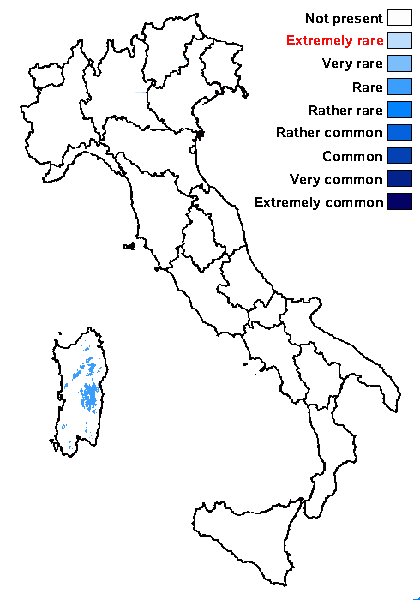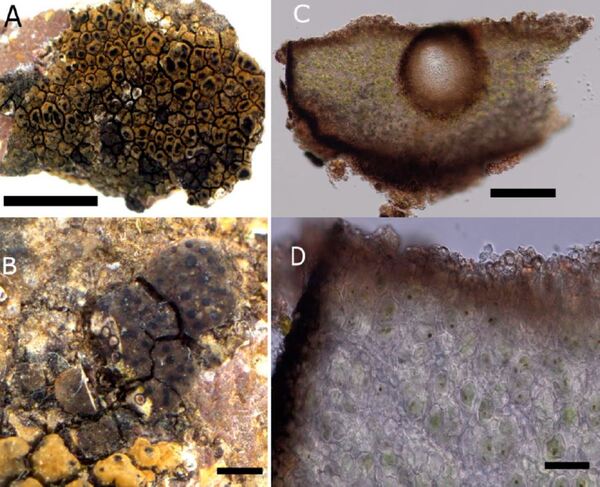Placopyrenium pseudocinereoatrum Thüs & Nascimbene
in Nascimbene & al. , J. Fungi, 9, 380: 14, 2023 (as "pseudocineroatrum")
Synonyms:
Distribution: C - Sar (Nascimbene & al. 2023).
Description: Thallus crustose to subsquamulose, well-delimited, up to 0.46 mm thick, rimose-areolate, starting the development on the thalli of Circinaria ochracea, later becoming independent, the areoles angular, constricted at base, 0.5-1 mm wide, flat to slightly convex, the peripheral ones slightly elongated, pale grey to mid-brown with black sides, faintly to distinctly pruinose (due to the epinecral layer); young thalli thinner, at first visible as a brown-grey patch on the host. Cortex poorly differentiated, paraplectenchymatous, the cell walls often with a brown pigment, locally with a more or less developed, c. 10 μm thick epinecral layer of dead but not collapsed cells; photobiont layer c. 200 μm thick, the algal cells arranged in clusters; medulla white or, in lower parts of thallus, with a brownish pigment in parasitic forms, brown-black in independently growing specimens. Perithecia immersed, globose, the apex often visible as a small brown dot. Involucrellum absent; exciple dark black-brown in upper part, brown in lower part, up to 240 μm in diam.; hamathecium of periphyses and periphysoids measuring c. 30 x 2 μm, interascal filaments absent; hymenial gel hemiamyloid. Asci 8-spored, clavate, I-, fissitunicate, the wall thickened above with an indistinct ocular chamber, Verrucaria-type. Ascospores 1-celled, hyaline, ellipsoid, 11-21 x 6.5-9.5 μm, without a distinct perispore, occasionally of distinctly different sizes in the same perithecium. Pycnidia immersed, the tips slightly projecting over the thallus, the wall colourless in lower part, black near the ostiole, multilocular, Dermatocarpon-type. Conidia simple, hyaline, bacilliform, straight or slightly curved, 4-7 x c. 1 μm. Photobiont chlorococcoid. Spot tests: cortex and medulla K-, C-, KC-, P-, UV-. Chemistry: without lichen substances.Note: a recently-described species growing in the splash zone of Mediterranean creeks which are sometimes dry in summer, starting the life-cycle on Circinaria ochracea. It is similar to P. cinereoatratum (Degel.) Orange, differing in the (on average) slightly shorter ascospores, the different host, and different ITS sequences. Hitherto known only from Sardinia
Growth form: Crustose
Substrata: rocks
Photobiont: green algae other than Trentepohlia
Reproductive strategy: mainly sexual
Periodically submerged (e.g. in creeks)
paras Circinaria ochracea
Commonnes-rarity: (info)
Alpine belt: absent
Subalpine belt: absent
Oromediterranean belt: absent
Montane belt: rare
Submediterranean belt: absent
Padanian area: absent
Humid submediterranean belt: absent
Humid mediterranean belt: absent
Dry mediterranean belt: absent

Predictive model


Source: Nascimbene & al. 2023
Italy, Sardinia
(A) Holotype of Placopyrenium pseudocinereoatrum with young perithecia (=SMNS-STU-F- 0002927) on Circinaria ochracea (=SMNS-STU-F0002797). (B) Isotype specimen with sectioned mature perithecia, SMNS-STU-F-0002808. (C) Section with young perithecium in subsquamulose Thallus part. (D) Thallus section with pseudocortex and photobiont layer from the holotype. (D) Scale bars in (A) = 5 mm, in (B) = 1 mm, (C) = 0.2 mm, (D) = 0.02 mm.
Growth form: Crustose
Substrata: rocks
Photobiont: green algae other than Trentepohlia
Reproductive strategy: mainly sexual
Periodically submerged (e.g. in creeks)
paras Circinaria ochracea
Commonnes-rarity: (info)
Alpine belt: absent
Subalpine belt: absent
Oromediterranean belt: absent
Montane belt: rare
Submediterranean belt: absent
Padanian area: absent
Humid submediterranean belt: absent
Humid mediterranean belt: absent
Dry mediterranean belt: absent

Predictive model



